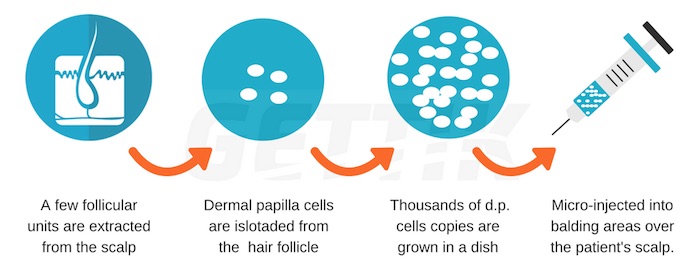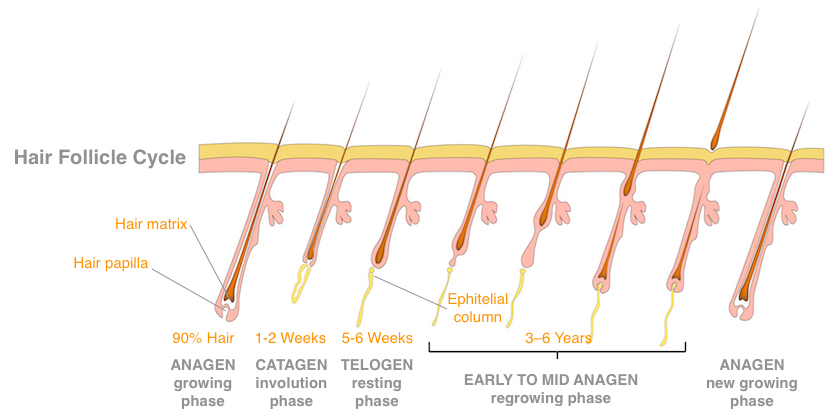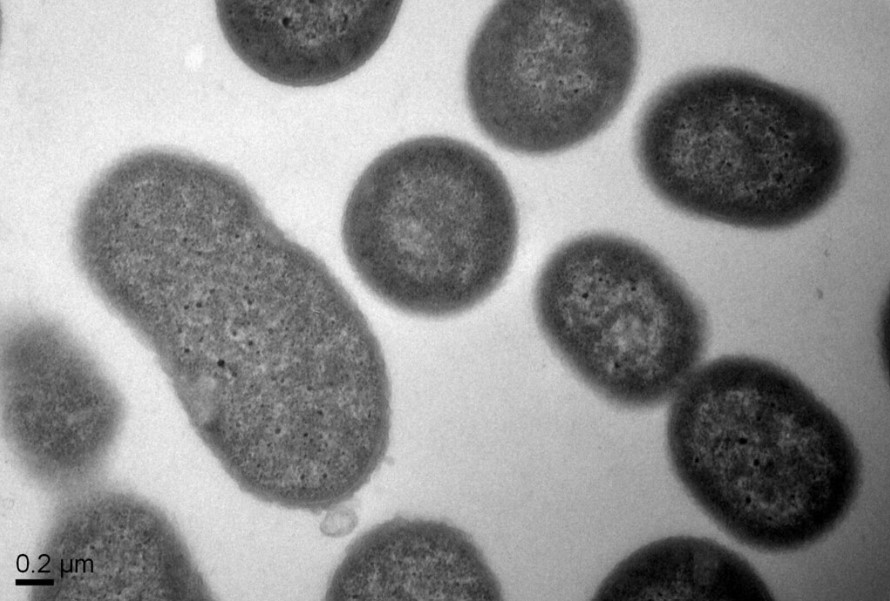How did Elon Musk grow his hair back? 6 Options
If you are currently reading this article, you’ve probably noticed that Elon’s hair has changed quite a lot and looks

Hair cloning is one of the most promising treatments for common genetic hair loss (a.k.a. androgenetic alopecia). It is being researched by pioneering hair restoration physicians such as Dr. Bernstein, who works in collaboration with Columbia University and hopes to be the first to develop a treatment for hair loss.
Hair cloning is one of the latest fields of scientific research to make rapid advances in the quest to cure genetic baldness and androgenic alopecia.
The treatment involves the removal of around 60 to 120 hair follicles followed by the micro-dissection and removal of specific cells, which are multiplied inside a laboratory.
The new cells are then implanted into balding areas on the scalp to result in new and permanent hair. In theory, this “unlimited” supply of new hair can be created and then implanted using the original 60 to 120 follicles.
It has been suggested that this technology could become a reality by 2027.
However, substantial work is required to make “hair cloning” a successful option.
To know the processes involved in “hair cloning”, you first have to understand hair growth cycle as well as sheds. Hair regenerates naturally in a cyclical pattern which involves:

The stem cells found in the hair follicle base (the dermal papilla) controls regeneration processes.
The presence of an abundance of these stem cells results in fuller and thicker hair. When it comes to female and male hair loss, the number of dermal-papilla cells decreases during the anagen phase, along with subsequent hair which is miniaturized.
Eventually, dermal papilla stop generating enough cells for regeneration.
Once this occurs, there are no new hairs that need replacing and the older hair falls out, resulting in baldness.
A rich shampoo that infuses weightless volume. With Biotin & ProVitamin B5.
No Parabens or Sulfates.
Hair cloning is a process that involves the extraction of a small amount of follicular units from the scalp. The extraction is done using a local anesthetic.
These follicular units will then be cryopreserved and banked until needed.
This will be followed by unfreezing a few of the follicular units. Then processing these units to isolate specific cells that are actively involved in the production of a hair shaft.
The cells will then divide and multiply.
The cells will be injected into balding areas over the patient’s scalp.
These implants are designed to rejuvenate thinning hair and result in the production of thicker hair shafts.
The idea behind hair-cloning process involves extraction of healthy hair-follicle cells from the patient, followed by cultivating a number of clones “in vitro”.
After a period of time, the cloned cells are transplanted back into the patient’s scalp.
Hair multiplication involves hair follicles which are extracted and transplanted onto the bald areas where they will regenerate.
In hair cloning, germinative cells are usually multiplied outside the body, ideally in unlimited amounts.
On the other hand, hair multiplication involves removing hair follicles from the donor‘s scalp and manipulating them such that the number of hairs is increased significantly.
This might involve cutting or transecting hair follicles and directly implanting them into the scalp, in the hope that the hair follicles will regenerate and grow new hair.
There is another technique that uses plucked hair fragments instead of transected or whole follicles.
Hair multiplication using plucked hair is based on the idea that it’s an easy, non-invasive way to obtain germinative cells.
Furthermore, the shaft of the plucked hair serves as a ready-made scaffold where the germinative cells are introduced and aligned at the new site.
Here, the goal is to pluck a small part of the germinative cells to provide enough tissue for the formation of new follicles, while not weakening the original one.
The main problem with this method is that plucking usually yields hair with too few cells to effectively induce new hair follicles to form.
Another form of hair multiplication involves plucking hairs from the beard or the scalp that are then implanted into the bald part of the scalp.
The idea here is that the germinative cells on the base of the hair follicle are highly likely to be pulled together with the follicle.
When the hair has been implanted, the cells will be able to regenerate and create a new follicle.
Examining the plucked hair via a microscope helps the doctor establish which hairs have the most stem cells and the ones that are more likely to regrow.
This procedure is referred to as “hair multiplication”, as the plucked follicles will regrow new hair, which can potentially offer an unlimited supply.
However, this technique usually has a problem in that when plucked. The cells adherent to the hair shaft don’t seem to play a major role in hair follicle growth.
Plus, the most important stem cells for hair growth, usually found around the bulge region of the follicle, often are not harvested to a significant degree.
Some researchers speculate that adding an extra-cellular matrix (ECM) with the aim of stimulating growth makes the plucked hairs much more likely to survive after they’re implanted. They may grow into fully developed hair.
However, this has been hard to document or prove in clinical trials.
The major limitation of using this new ECM-based technique is that most of the plucked hairs do not contain adequate germinative material to effectively stimulate new hair growth.
This means that only a small number of plucked hairs are actually useful in the transplant.
The other concern with this method is that a portion of the new hair is usually obtained from the skin around the recipient site instead of being solely from the transplanted hair follicle.
For this reason, we can only hope that the new hair, which contains cells from the donor as well as the recipient, will be resistant enough for the miniaturizing actions of DHT and that it won’t disappear over time.
Solve thin hair immediately. The visible scalp will disappear instantly.
Hair follicles present a major challenge when it comes to cloning.
This is because the follicles are usually very complex. It’s difficult to multiply them inside a test tube; too, since they are not whole organisms. They cannot grow on their own.
Luckily, a pair of clever scientists, Dr. Colin Jahoda and Dr. Amanda Reynolds, seem to be on their way towards solving the dilemma.
In a report titled Transgender Induction of Hair Follicles, these scientists have highlighted that dermal sheath cells found in the lower parts of the human hair follicle can be isolated from one person and directly injected into the skin of another to form new intact hair.
To stimulate the development of normal, full-terminal hair follicles, the implanted cells interact locally inside the skin of the recipient.
While this is not actual hair cloning, there’s a good chance that dermal sheath cells can be multiplied inside a petri dish and later injected into the skin in great numbers to create a full head of hair.
But this form of multiplication has not been achieved yet, so take this scenario with a grain of salt.
Nonetheless, it seems that this kind of hair “induction” method is the model that is most likely to work.

Interestingly, in the experiment, the donor cells actually came from a male while the recipient, a female, actually grew the hair.
This aspect highlights that donor cells can successfully be transferred from one person to another without being rejected. Even in cases where the recipient was not only of the opposite sex, but also had a significantly different genetic profile, repeated implantations didn’t produce the usual rejection responses.
This shows that dermal sheath cells usually have a special immune status, and that the lower part of the hair follicle is one of the “immunity privileged” sites of the human body.
Additionally, some evidence shows that the recipient’s skin can actually affect the look of the hair. Therefore, the final appearance of the patient is more likely to resemble the original hair of the bald person more closely than that of the inducer cells of the donor.
There are four main experimental techniques for cloning hair:
However, though they are minor, there are a few safety concerns that the implanted cells can exhibit malignant growth or induce tumors themselves.
But once such obstacles are overcome, certain FDA requirementsto must be met before approval to guarantee effectiveness and safety. The process entails three formalized clinical tests and usually takes years.
Hair cloning is still a work in progress, and although there has been significant recent success – especially now that we have a working model of how it might be accomplished – there’s still much work to be done.
When cloning hair, we are still confronted with a number of problems.
1. First, we need to determine the most appropriate follicular components to use. The dermal sheath cells used in the Jahoda/Amanda experiment are difficult to isolate, and may not necessarily produce the best hair.
2. Second, the extracted cells must be cultured successfully outside the body.
3. Third, a cell matrix could be required to keep the cells aligned properly when they are growing.
Finally, the cells should be injected successfully into the scalp of the recipient in a way that they can consistently induce hair growth.
With cell implantation, there are no guarantees that the induced hair will look natural in terms of color, texture, or thickness, or that the hair will grow in the right direction.
This is unlike the conventional Follicular Unit Extraction (FUE) procedure where intact follicular units are implanted into the scalp, oriented in the direction the surgeon intends the hair to grow.
To alleviate the problem, the induced hair might be used in the central part of the scalp for volume purposes, and complemented using the traditional FUE procedure to produce a natural appearance.
Nonetheless, it must be ascertained that induced hair follicles can actually grow long enough to create cosmetically significant hair.
Once the hair is shed as part of the normal hair cycle, there is no guaranteed that it will grow and cycle again.
Another major technical problem in hair cloning is that the cells in culture usually start differentiating as they multiply and degenerate. Also act like fibroblasts instead of hair.
Finding the ideal environment where the cells can thrive in a way that differentiates them in a hair-like state is a big challenge for researchers.
In fact, it seems to be the single largest obstacle keeping this form of hair-loss treatment therapy from coming to fruition. It’s quite similar to the problems encountered in cloning an entire organism, since the environment where the embryonic cells grow is crucial to their proper differentiation and survival.
Stem cell and organ cloning research still in its infancy.
And even though hair cloning sounds simple in theory, there are unexpected complications when it comes to any of the latest medical technologies.
Nevertheless, research continues and every day researchers get closer and closer to a successful cure for baldness and androgenic alopecia.
With hair cloning, a sample of the patient’s germinative hair follicle cells are multiplied in vitro (outside the body). Then re-implanted into the scalp in the hope that new hair follicles will grow from them, thereby creating new permanent hair.
This is a fascinating field. Not only due to the rapidly developing nature of the science of cloning hair. But also because hair cloning methods have huge potential to yield an effective treatment that “cures” common hair loss. Many physicians and scientists have been seeking this cure for decades.
Hair cloning is a term that encompasses many different sets of ideas on how laboratory techniques can be used to solve the problem of hair loss. However, there are technical differences between true hair cloning and the hair multiplication technique for treating baldness.
If you are currently reading this article, you’ve probably noticed that Elon’s hair has changed quite a lot and looks

How Does Swimming Affect Your Body? Individuals swim for a variety of reasons including recreation, competition, and health. Regardless of

Lifestyle Tips For Better Overall Health The way you go about your daily life has a massive and direct impact

How Do Infections Work and What Are Their Effects on the Body? From Hippocrates’s writings about the spread of disease

How To Make a Good Impression in a Job Interview When it comes to getting a job, interviewing may seem